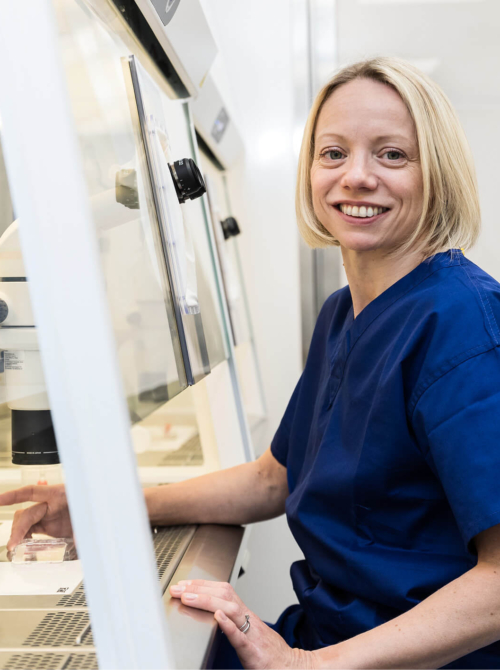How do multiple pregnancies occur in IVF?
Multiple pregnancy in IVF means carrying more than one baby after treatment, most often twins, very rarely triplets. It is a topic that matters for safety and for success, because multiple pregnancy raises risks for mothers and babies and places extra pressure on the NHS.
In our companion article, single or multiple embryo transfer, we explain why aiming for one healthy baby at a time is usually the safest and most effective plan. You can read that piece here, single or multiple embryo transfer, what is safest and most effective, and learn why a clinic’s multiple birth rate should be part of your decision.
The two main ways multiple pregnancies happen in IVF
There are two principal routes to a multiple pregnancy in IVF.
- Two embryos implant after transfer
If two embryos are transferred in the same cycle and both implant, a twin pregnancy can result. This is why many clinics, including ours, recommend elective single embryo transfer for suitable patients, to keep you safe without reducing your overall chance of success across a full course of treatment. - One embryo splits after transfer
Multiple pregnancy can also occur after a single embryo transfer if the embryo splits into two, which creates identical twins. This is called monozygotic twinning. In very rare cases, an embryo can divide more than once, leading to identical triplets, although this is exceptional.
There are also rare situations where a transferred embryo implants and a separate natural conception occurs in the same cycle. This is uncommon; however, it is one reason clinics give clear advice about intercourse and timing around treatment.
How embryo splitting happens
Embryo splitting is a natural biological event. It can happen at different points in early development.
- If splitting happens very early, soon after fertilisation, each twin typically develops its own placenta and its own amniotic sac. This is called dichorionic diamniotic.
- If splitting occurs a little later, often around the formation of the inner cell mass at the blastocyst stage, twins may share a single placenta but have two sacs. This is called monochorionic diamniotic.
- If splitting occurs later still, the twins can share both the placenta and the sac. This is called monochorionic monoamniotic, and it needs close specialist monitoring.
- There are, of course, rare instances where an embryo divides after implantation. These cases are unusual, but they can occur, which is why early ultrasound to confirm the number of babies and the type of placentation is so important.
The exact trigger for splitting is not fully understood. Natural biology is the main factor. Scientific papers have explored whether some aspects of treatment are associated with a slightly higher rate of identical twinning, for example, blastocyst stage transfer, assisted hatching, micromanipulation such as ICSI, or biopsy for genetic testing.
Evidence is mixed, and associations do not prove cause. Our approach is to minimise non-essential manipulation in the laboratory, to handle embryos with the greatest care, and to counsel patients clearly.
Why does a multiple pregnancy carry a higher risk?
Multiple pregnancy is linked with higher rates of preterm birth, low birth weight, and the need for neonatal intensive care. For mothers, risks include pregnancy-induced hypertension, pre-eclampsia, gestational diabetes and a higher chance of caesarean section. These are serious considerations.
The safest strategy is to reduce the chance of a multiple pregnancy while keeping success rates strong, which is the aim of modern embryo transfer policy and why single embryo transfer is recommended in many situations.
What clinics do to reduce the risk
A responsible clinic takes a number of steps to keep patients safe while maintaining excellent outcomes.
- Favour single embryo transfer when appropriate
For many patients, especially those with good quality embryos, transferring one embryo gives the best balance of safety and success. Any additional embryos can be frozen and used in later cycles if needed, which preserves cumulative live birth potential without the added risks of twins. - Optimise the plan, then keep it flexible
Your plan is based on your history, age, embryo quality and medical factors. We then monitor and adjust at every scan and every blood test, so treatment follows your physiology, not a timetable. - Minimise non-essential manipulation
In the lab, we avoid unnecessary procedures that thin or open the outer shell of the embryo, and we use gentle techniques during embryo handling and transfer. - Provide clear counselling
We explain the small chance of identical twinning after single embryo transfer, we talk about how that is managed if it happens, and we advise on the timing of intercourse to avoid the rare scenario of a natural conception in the same cycle.
What happens if a multiple pregnancy is confirmed
If an early scan shows more than one heartbeat, the first step is to determine chorionicity and amnioticity, in simple terms, whether the babies share a placenta or a sac.
This helps plan care. You will be referred to appropriate specialist teams, and your pregnancy will be monitored more closely with extra scans and appointments. The goal is to support the healthiest possible outcome, with clear information and joined-up care.
How does this link to your decision about one or two embryos?
Understanding how multiple pregnancies occur helps you make an informed choice about embryo transfer. For a practical guide to choosing between single embryo transfer and multiple embryo transfer, and for a reminder to check a clinic’s multiple birth rate alongside its live birth rate, read our companion article, Single or multiple embryo transfer, what is safest and most effective?
At The Evewell our multiple birth rate is amongst the lowest in the UK, based on HFEA verified data. If you have questions about your own plan, book a consultation. We will review your history and your embryos and create a pathway that balances the best chance of success with the safest path to one healthy baby at a time.
Tags
All Categories
Discover more
Frequently asked questions
Identical twins occur in natural and IVF pregnancies. Some studies suggest small associations with certain techniques; however, evidence is mixed, and the absolute risk remains low. We focus on careful handling and only perform procedures that add clear value to your care.
Transferring two embryos increases the chance of twins; it does not simply double the chance of one baby. In suitable patients, a single high-quality embryo can give the same overall chance of a baby across a full course of care, because any remaining embryos can be used in later frozen cycles.
Sometimes this is discussed, for example, in older patients or where embryo quality is limited. It is never routine. It involves careful counselling about the additional risks and a shared decision that considers your medical history and your priorities.





